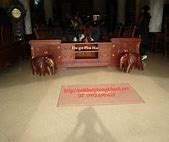
Thăng Long Tv Là Ai Wikipedia
Thăng Long (chữ Hán: tên cũ 昇龍, tên mới 昇隆) là tên gọi cũ của thành phố Hà Nội. Đây là kinh đô của nước Đại Việt thời Lý, Trần, Lê, Mạc, Lê Trung hưng (1010 - 1788). Trong dân dã thì địa danh tên Nôm Kẻ Chợ được dùng phổ biến nên thư tịch Tây phương về Hà Nội trước thế kỷ 19 hay dùng Cachao hay Kecho.
Thăng Long (chữ Hán: tên cũ 昇龍, tên mới 昇隆) là tên gọi cũ của thành phố Hà Nội. Đây là kinh đô của nước Đại Việt thời Lý, Trần, Lê, Mạc, Lê Trung hưng (1010 - 1788). Trong dân dã thì địa danh tên Nôm Kẻ Chợ được dùng phổ biến nên thư tịch Tây phương về Hà Nội trước thế kỷ 19 hay dùng Cachao hay Kecho.
North Gate (Cửa Bắc, or Bắc Môn)
The North Gate is the last standing gate of five built for the Nguyễn dynasty reconstruction of the citadel. The structure is mainly built of embellished brick and stone, and Lê dynasty foundations were found near the structure in 1998.[2] The north face of the structure has cannon marks from the 1882 Battle for the Hanoi Citadel.
From 1954 to 1975, the People's Army of Vietnam, had its headquarters within the Citadel. Building D67 was constructed (as the name suggests) in 1967. It was built the contemporary architectural style (to look like a house and hide its military significance) with many defensive features, including a 60-centimeter thick soundproofing wall, reinforced entrances, and a connecting tunnel that allowed for emergency evacuation in case of an attack.[2] The building currently serves as a museum which exhibits tools that comrades in the Politburo and the Central Military Commission, the Ministry of Defense and the General Staff used in the Vietnam War. The building and tunnel are situated on the northern part of the Kinh Thiên Palace foundations.[15]
Vị trí Thăng Long tứ trấn trên bản đồ Hà Nội
Thăng Long tứ trấn là tên gọi chỉ 4 ngôi đền thiêng thờ 4 vị thần trấn giữ 4 vị trí huyết mạch phía đông, tây, nam, bắc của kinh thành Thăng Long xưa.[1] Bốn ngôi đền bao gồm:[2][3]
Ngày 18 tháng 1 năm 2022, Thủ tướng Chính phủ ban hành Quyết định số 93/QĐ-TTg xếp hạng di tích lịch sử và kiến trúc nghệ thuật Thăng Long tứ trấn là di tích quốc gia đặc biệt.[4][5]
Đền Bạch Mã nằm tại địa chỉ số 76 phố Hàng Buồm, quận Hoàn Kiếm. Đây là đền thờ thần Long Đỗ, vị Thành hoàng của Thăng Long xưa[6]. Theo sử liệu, đền Bạch Mã được khởi dựng dưới thời nhà Đường khi Cao Biền xây La thành vào năm 866. Sau khi Lý Thái Tổ dời đô từ Hoa Lư ra Thăng Long vào năm 1010 thì đền được xây dựng lại. Đền được xây theo hình chữ "tam", bên ngoài là phương đình tám mái. Điểm đặc sắc của công trình kiến trúc này chính là hệ thống mái hình "vỏ cua" (hình mai con cua) liên kết giữa các hạng mục kiến trúc. Đền hiện còn bảo quản được tượng và nhiều di vật quý như tượng thần Long Đỗ từ thời nhà Lê - thế kỷ XVII, 18 bia đá cổ, 17 đạo sắc phong thời Nguyễn, nhiều đồ thờ tự khác.[7][8][9]
Đền Voi Phục có các tên khác là Đền Thủ Lệ, Đền Linh Lang hiện tọa lạc tại phố Kim Mã, quận Ba Đình cạnh công viên Thủ Lệ. Đền thờ thần Linh Lang Đại vương, người có công đánh dẹp quân Tống trên vùng đất Thăng Long xưa[10]. Tương truyền, đền Voi Phục được xây dựng năm Chương Thánh Gia Khánh thứ 7 (1065) đời vua Lý Thánh Tông trên một khu gò cao thuộc vùng đất của trại Thủ Lệ - một trong 13 làng trại ở phía tây kinh thành Thăng Long. Đền có kết cấu kiểu chữ "công" gồm tiền tế, trung đường, hậu cung. Trong đền có hai pho tượng đồng và hòn đá to có vết lõm, tương truyền là nơi Linh Lang nằm gối đầu lên rồi hóa thành con giao long. Ngoài cổng đền có tượng hai con voi quỳ phục, do đó mà thành tên gọi.[11][12][13]
Đền Kim Liên còn được gọi là Đền Cao Sơn, Đình Kim Liên tọa lạc tại phường Phương Liên, quận Đống Đa. Đền được lập nên từ thời vua Lê Tương Dực để thờ thần Cao Sơn Đại Vương. Tương truyền, thần Cao Sơn là con trai của Lạc Long Quân và Âu Cơ, là một trong 50 người con theo mẹ lên núi. Đền Kim Liên nằm trên gò cao, bao gồm tam quan và đền thờ thần. Đền chính được xây theo kiểu chữ "Đinh" gồm tòa bái đường năm gian ở phía trước, phía sau là chính điện (hậu cung) ba gian[14][15]. Về sau người dân làng Kim Liên đã lập thêm cổng tam quan, bổ sung một số kiến trúc mới tạo thành đình Kim Liên, trong đền và đình còn thờ Tam Phủ, thờ Mẫu... Đến nay, tại đình Kim Liên còn lưu giữ 39 đạo sắc phong cho thần Cao Sơn Đại Vương và tấm bia đá dựng phía trái đền.[14][16]
Đền nằm ở cuối đường Thanh Niên, nhìn chếch ra Hồ Tây[17]. Theo sử sách, đền Quán Thánh hay Quán Trấn Vũ thờ Huyền Thiên Trấn Vũ, tương truyền là người đã có công giúp vua An Dương Vương khi xây thành Cổ Loa. Đền được dựng trong Kinh thành từ thời nhà Lý (1160). Năm 1474, khi mở rộng Hoàng thành, vua Lê Thánh Tông cho di chuyển đền ra địa điểm hiện nay. Trong đền có tượng thánh Trấn Vũ bằng đồng đen, đúc năm 1677 đời Lê Hy Tông, cao 3,92 m và nặng khoảng 4 tấn.[18]
French colonial–revolutionary periods (19th–20th centuries)
When it was controlled by the French as the capital of Indochina (1885–1954), the Citadel of Hanoi was largely demolished to make the land for offices and barracks. Except for the North Gate and the Flag Tower, what remains of Hanoi citadel to this day is only an archaeological site and restored. Systematic restoration and excavation began in the 21st century.[3] In mid-1945 the Citadel was used by the Imperial Japanese Army to imprison over 4000 French colonial soldiers captured during the Japanese coup d'état in French Indochina in March 1945.[4]: 19–20
During the Vietnam War, the Imperial Citadel was used as an administrative capital and headquarters for the North Vietnamese Ministry of Defense and Army. During and after the revolution, several French structures were destroyed or re-appropriated, including what is now the Vietnam Military History Museum (formerly a French military headquarters).[2] Between 1998 and 2000, minor renovations were made to the site so that it would be more accessible and safe for visitors.[2] Major archeological discoveries were made as part of a construction project in 2002–2004. In 2004, the Ministry of Defense moved from the Central Sector of the site so that the relics could be more completely conserved by the Hanoi People's Committee Department of Culture and Information.
In 2009, the Citadel was inscribed as a Special Relic of National significance (Special National Site), making it the first site listed under that category.[5] The Central Sector of the Imperial Citadel was listed in UNESCO's World Heritage Site on July 31, 2010, at its session in Brazil, as "The Central Sector of the Imperial Citadel of Thăng Long – Hanoi".[6][7] The site has undergone several modifications as part of a larger ongoing plan for restoration.[8] Some of these renovations and their efficacy have become controversial.[9]
The Lý dynasty royal palaces and edifices were largely destroyed by the Nguyễn dynasty during reconstruction in the early 19th century. Many Nguyễn dynasty structures were later destroyed in the late 19th century during periods of French and Japanese control. The few remaining structures within the royal compound are the Main Gate (Đoan Môn), marking the southern entrance to the royal palace; the Hanoi Flag Tower (Cột cờ Hà Nội); the steps of Kinh Thiên Palace (Điện Kính Thiên); and the Rear Palace (Hậu Lâu).
Architectural and foundational remains of the Imperial City were discovered on the site of the former Ba Đình Hall at 18 Hoàng Diệu Street when the structure was torn down in 2008 to make way for a new parliament building. Various archaeological remains unearthed were brought to the National Museum to be exhibited. Thus far only a small fraction of Thăng Long has been excavated.[2] Since the initial excavation, many restoration and heritage preservation projects have occurred at the site, including several National projects[8] and a successful push for UNESCO recognition.[3] The recognized world heritage site is about 18 hectares comprising two primary areas the Hanoi Ancient Citadel itself, where most of the standing Nguyễn dynasty remain, and the Archaeological Site 18 Hoàng Diệu Street directly to the East (including a buffer zone of 108 hectares for a protected area of about 126 hectares, out of a total of 140 hectares containing the entire Imperial Citadel).[2][10] The Ancient Citadel is constructed on a slightly offset north–south axis and organized according to traditional geomantic principles (phong thuy; feng shui) which give the site a historic and spiritual significance.[2]
Lê–Mạc period (15th–18th centuries)
Following a successful revolution against the Ming dynasty occupation, Lê Lợi took the reign name Lê Thái Tổ and established the Lê dynasty in 1428, with the capital still in Thăng Long under the new name of Đông Kinh. The rule of Đông Kinh under the Lê dynasty was very similar to the rule of Thăng Long under the Lý dynasty, with the change of name being largely symbolic. Lê Thái Tổ ordered repairs to the citadel after the damage caused left by the war with the Ming army.
Rulers during the Mạc dynasty, controlled Đông Kinh from 1527 until 1592. In 1585 a period of construction began under Mạc Mậu Hợp. In 1592, the citadel was seized by armies from the Revival Lê dynasty and re-established as the dynasty's capital city, undergoing more repairs in 1599 and serving as a symbolic seat of power and administrative heartland for the Trịnh lords.[1]


















